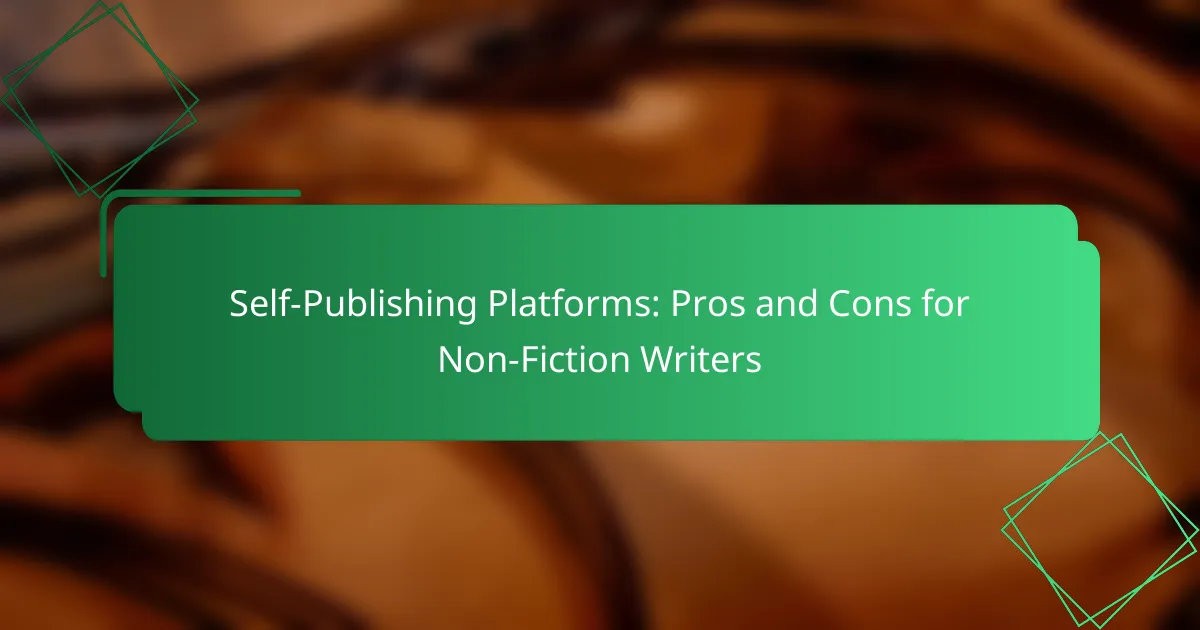Self-publishing has become a popular avenue for non-fiction writers, providing them with the opportunity to share their expertise and insights with a global audience. While platforms like Amazon Kindle Direct Publishing and IngramSpark offer benefits such as higher royalty rates and creative control, they also present challenges that authors must navigate. Understanding both the pros and cons of these platforms is crucial for making informed decisions in your publishing journey.
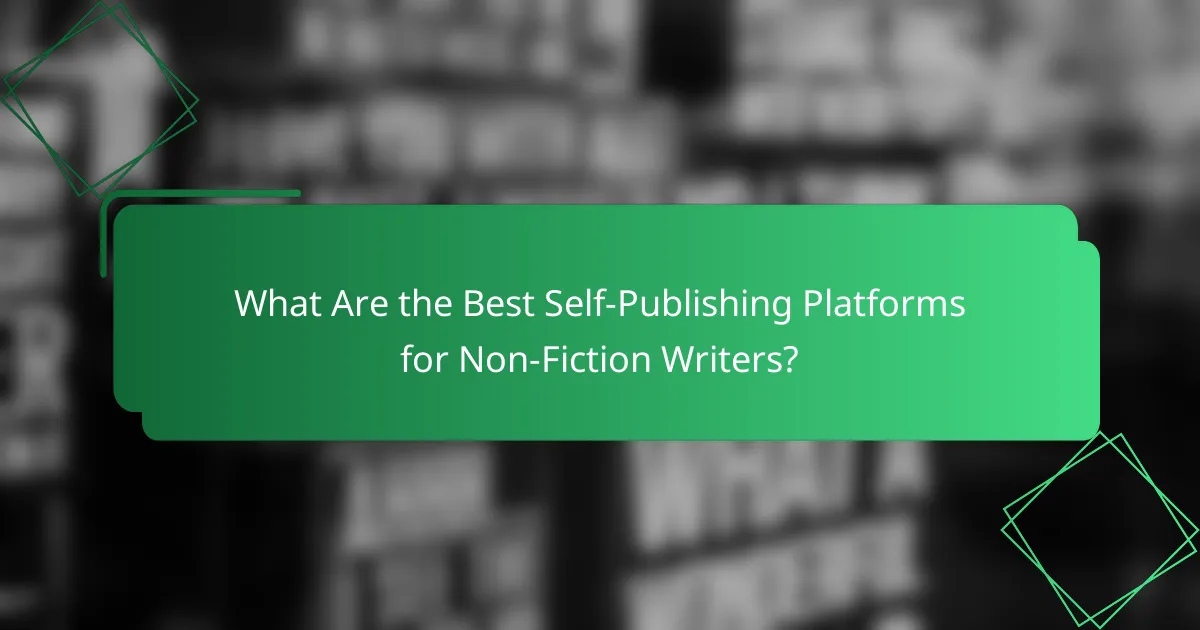
What Are the Best Self-Publishing Platforms for Non-Fiction Writers?
The best self-publishing platforms for non-fiction writers include Amazon Kindle Direct Publishing, IngramSpark, Smashwords, Draft2Digital, and Apple Books. Each platform offers unique features, distribution options, and pricing structures that cater to different needs and goals of authors.
Amazon Kindle Direct Publishing
Amazon Kindle Direct Publishing (KDP) is a leading platform for self-publishing eBooks and paperbacks. It allows authors to publish their work quickly and reach millions of readers worldwide through Amazon’s marketplace.
Authors can set their own prices and earn royalties ranging from 35% to 70% depending on the pricing model. KDP also offers promotional tools, such as Kindle Unlimited, which can help increase visibility and sales.
IngramSpark
IngramSpark is a robust platform that provides extensive distribution options for both print and eBooks. It connects authors to a wide network of retailers, libraries, and online platforms, making it ideal for those looking to reach a broader audience.
While IngramSpark charges a setup fee, it offers high-quality print options and the ability to distribute globally. Authors should consider the costs and potential returns when deciding if this platform fits their publishing strategy.
Smashwords
Smashwords is an eBook distribution platform that allows authors to publish their work and distribute it to major retailers like Barnes & Noble, Apple Books, and Kobo. It is user-friendly and offers a straightforward publishing process.
Authors can set their own prices and benefit from a royalty rate of around 60% for sales through Smashwords. However, it’s essential to ensure that the formatting meets their guidelines to avoid delays in publication.
Draft2Digital
Draft2Digital is another popular self-publishing platform that simplifies the eBook publishing process. It offers free formatting tools and distributes to various retailers and libraries, including Amazon and Apple Books.
Authors earn around 60% of the retail price, and Draft2Digital takes a small percentage of the royalties. This platform is particularly appealing for those who want an easy-to-use service without upfront costs.
Apple Books
Apple Books is a direct publishing platform for authors looking to reach Apple users. It allows for the publication of eBooks and offers a clean, user-friendly interface for both authors and readers.
Authors can set their own prices and earn a 70% royalty on sales. However, it’s important to note that Apple Books is primarily accessible to those with a Mac or iOS device, which may limit some authors’ ability to publish directly.
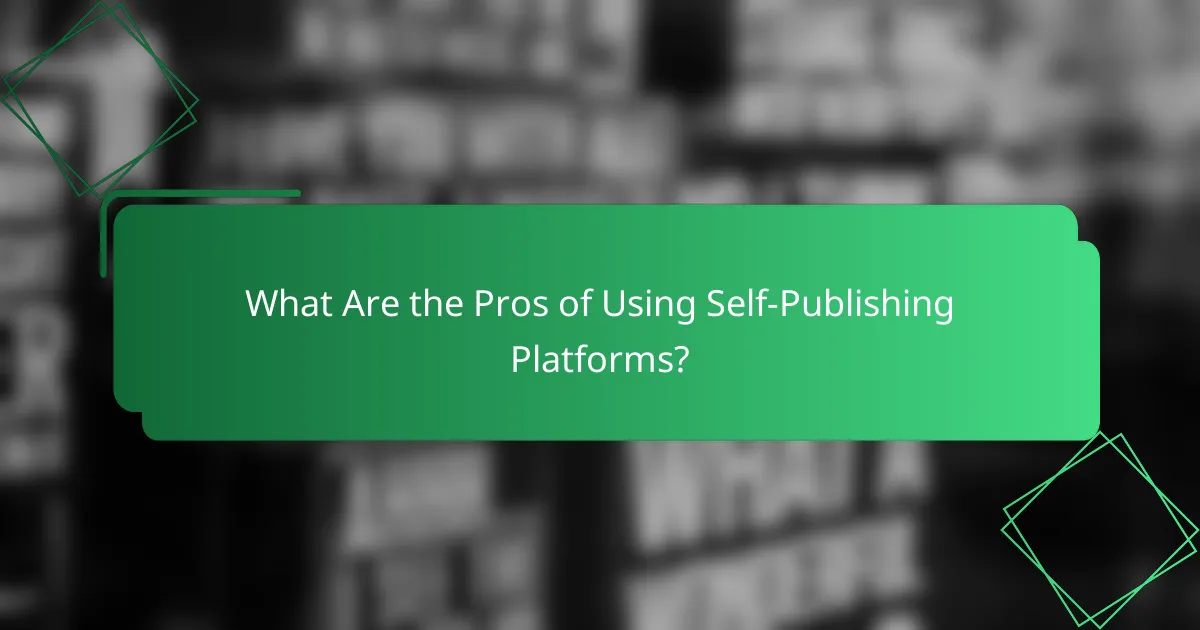
What Are the Pros of Using Self-Publishing Platforms?
Self-publishing platforms offer non-fiction writers significant advantages, including higher royalty rates, creative control, a faster publication process, and global distribution. These benefits empower authors to maximize their earnings and reach wider audiences without the constraints of traditional publishing.
Higher royalty rates
One of the main advantages of self-publishing is the potential for higher royalty rates. Traditional publishers typically offer royalties ranging from 10% to 15% of the book’s sales price, while self-publishing platforms can provide authors with royalties of 60% to 80% or more. This means that for every book sold, self-published authors can keep a larger share of the profits.
However, it’s essential to consider the platform’s fees and pricing structure, as these can affect overall earnings. For instance, some platforms may charge a percentage of sales or require upfront costs, so it’s crucial to evaluate the net income after these deductions.
Creative control
Self-publishing allows authors to maintain complete creative control over their work. This includes decisions about content, cover design, formatting, and marketing strategies. Writers can express their unique voice and vision without the compromises often required by traditional publishers.
While this freedom is empowering, it also means that authors must take on the responsibility of ensuring quality and professionalism. Investing in professional editing and design services can enhance the final product and improve marketability.
Faster publication process
The self-publishing process is generally much quicker than traditional publishing, which can take months or even years. Authors can often publish their work within a few weeks, allowing them to respond to market trends or current events more effectively. This speed is particularly advantageous for non-fiction writers who want to capitalize on timely topics.
To expedite the process, authors should prepare their manuscripts thoroughly and familiarize themselves with the chosen platform’s submission guidelines. This preparation can help avoid delays and ensure a smoother publication experience.
Global distribution
Self-publishing platforms typically offer global distribution, allowing authors to reach readers worldwide. This access can significantly expand an author’s audience and increase sales potential. Many platforms distribute to major online retailers, including Amazon, Apple Books, and Barnes & Noble.
Authors should consider the implications of global distribution, such as pricing strategies and regional market preferences. Adjusting pricing for different countries and understanding local reader preferences can enhance sales and visibility in diverse markets.
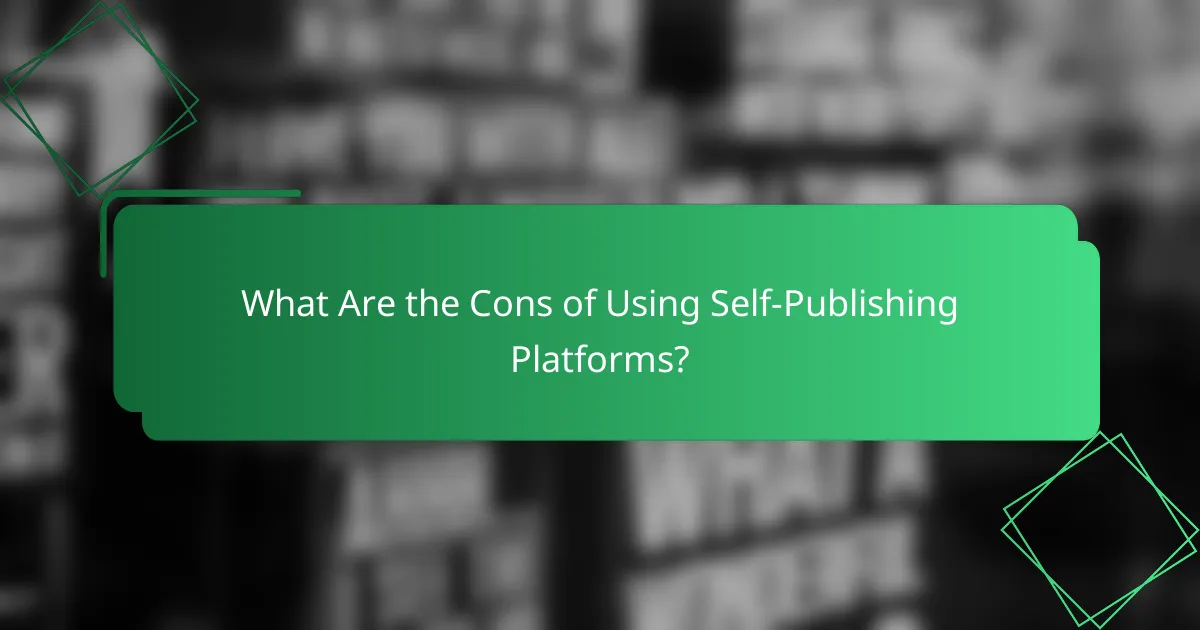
What Are the Cons of Using Self-Publishing Platforms?
Self-publishing platforms offer many advantages, but they also come with significant drawbacks for non-fiction writers. Understanding these cons is essential for making an informed decision about your publishing journey.
Marketing responsibility
When you choose to self-publish, the burden of marketing falls entirely on you. Unlike traditional publishing, where publishers often handle marketing efforts, self-published authors must create and execute their own marketing strategies. This can include social media promotion, email campaigns, and even paid advertising.
To effectively market your book, consider building an author platform before publication. Engage with potential readers through blogs, newsletters, and social media to create a following that will support your launch.
Quality control issues
Self-publishing platforms often lack rigorous quality control, which can lead to poorly edited or formatted books. Without the oversight of a traditional publisher, authors may overlook critical elements such as grammar, design, and overall presentation. This can negatively impact reader perception and sales.
To mitigate quality issues, invest in professional editing and design services. Consider hiring freelancers or utilizing reputable services to ensure your book meets industry standards.
Limited support
Self-publishing platforms typically offer limited support compared to traditional publishing houses. Authors may find themselves navigating technical issues, formatting challenges, or distribution hurdles without adequate assistance. This lack of support can be overwhelming, especially for first-time authors.
Familiarize yourself with the platform’s resources and community forums. Engaging with other self-published authors can provide valuable insights and tips to help you overcome common challenges.
Potential for lower visibility
Self-published books often struggle for visibility in a crowded market. Without the backing of a traditional publisher, your book may not reach the same audience, making it harder to gain traction. Many readers still gravitate towards traditionally published works, which can limit your book’s exposure.
To enhance visibility, consider leveraging online platforms like Amazon and Goodreads. Participate in book promotions, join relevant online communities, and seek reviews to increase your book’s chances of being discovered by potential readers.
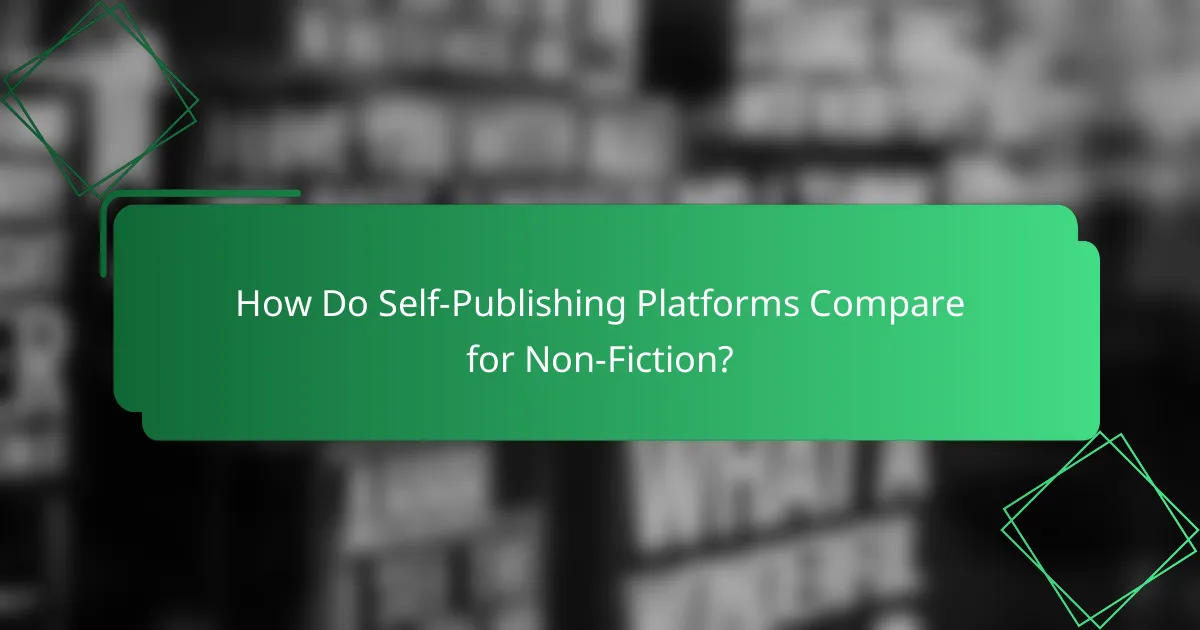
How Do Self-Publishing Platforms Compare for Non-Fiction?
Self-publishing platforms offer various options for non-fiction writers, each with distinct advantages and disadvantages. Understanding these differences can help authors choose the right platform based on their specific needs and goals.
Cost analysis
The cost of using self-publishing platforms can vary significantly. Many platforms charge a flat fee for publishing, while others take a percentage of sales. For example, platforms like Amazon Kindle Direct Publishing (KDP) have no upfront costs but retain around 30-65% of royalties, depending on pricing.
Writers should also consider additional expenses such as editing, cover design, and marketing. Budgeting for these services can range from a few hundred to several thousand dollars, depending on the quality and extent of the services chosen.
Distribution reach
Distribution reach is a critical factor for non-fiction authors. Some platforms, like KDP, provide access to a vast audience through Amazon, while others may offer limited distribution options. Platforms like IngramSpark can distribute to bookstores and libraries, expanding an author’s reach beyond online sales.
Writers should evaluate their target audience and where they are most likely to purchase books. Choosing a platform that aligns with the intended distribution channels can significantly impact sales potential.
Formatting requirements
Formatting requirements can differ across self-publishing platforms, affecting the ease of getting a book ready for publication. Most platforms accept common formats like Word documents or PDFs, but specific guidelines must be followed for eBooks and print versions.
Authors should familiarize themselves with each platform’s formatting standards, which may include font size, margins, and file types. Investing time in proper formatting can prevent delays and ensure a professional appearance, which is crucial for non-fiction credibility.
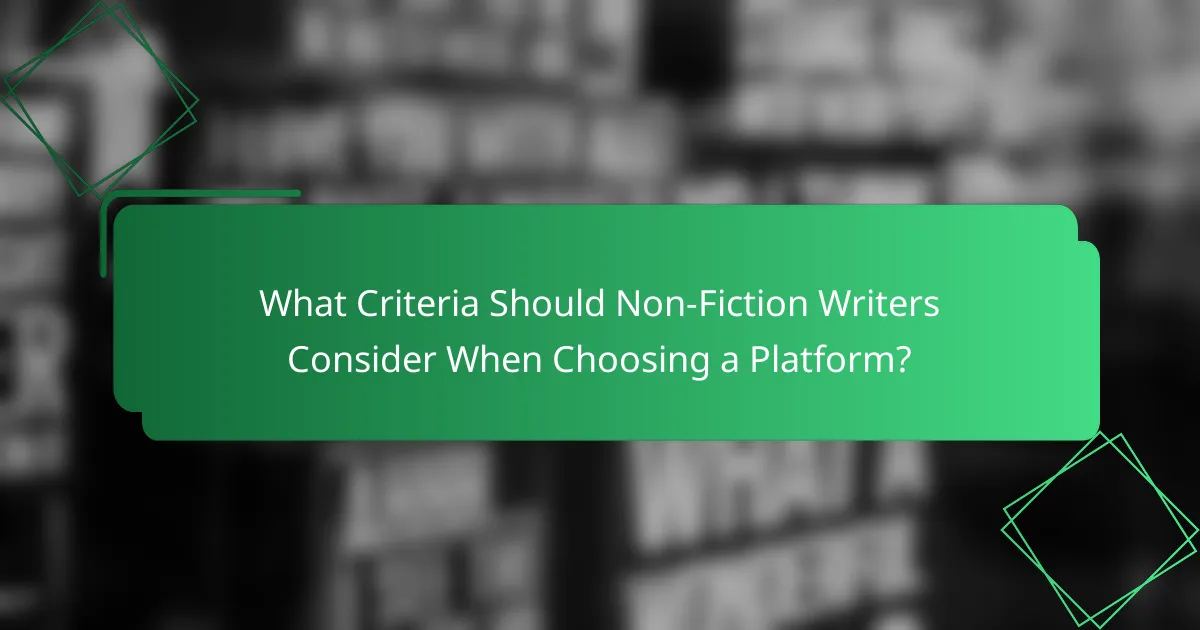
What Criteria Should Non-Fiction Writers Consider When Choosing a Platform?
Non-fiction writers should consider factors such as ease of use, distribution options, royalty rates, and support services when selecting a self-publishing platform. These criteria can significantly impact the success and reach of their published work.
Ease of Use
Choosing a user-friendly platform is crucial for non-fiction writers, especially those new to self-publishing. Look for platforms that offer intuitive interfaces and clear guidance throughout the publishing process. A straightforward setup can save time and reduce frustration.
Consider platforms that provide templates tailored for non-fiction, which can help streamline formatting and design. This feature can be particularly beneficial for writers who may not have design experience.
Distribution Options
Distribution is a key factor in getting your non-fiction work into the hands of readers. Evaluate platforms based on their reach to major retailers, libraries, and international markets. Some platforms may offer wider distribution networks than others.
Additionally, check if the platform allows for both digital and print options. Having the flexibility to publish in multiple formats can enhance visibility and sales potential.
Royalty Rates
Royalty rates can vary significantly between self-publishing platforms, impacting your earnings. Most platforms offer royalties ranging from 35% to 70% for eBooks, while print royalties may be lower. Understanding these rates is essential for budgeting and financial planning.
Compare the royalty structures of different platforms to find one that aligns with your financial goals. Some platforms may offer higher rates but charge fees for additional services, so be sure to factor those into your decision.
Support Services
Access to support services can greatly enhance your self-publishing experience. Look for platforms that provide resources such as marketing assistance, editing services, and customer support. These services can help you navigate challenges and improve your book’s quality.
Consider platforms that offer community forums or workshops for writers. Engaging with other authors can provide valuable insights and encouragement throughout your publishing journey.
